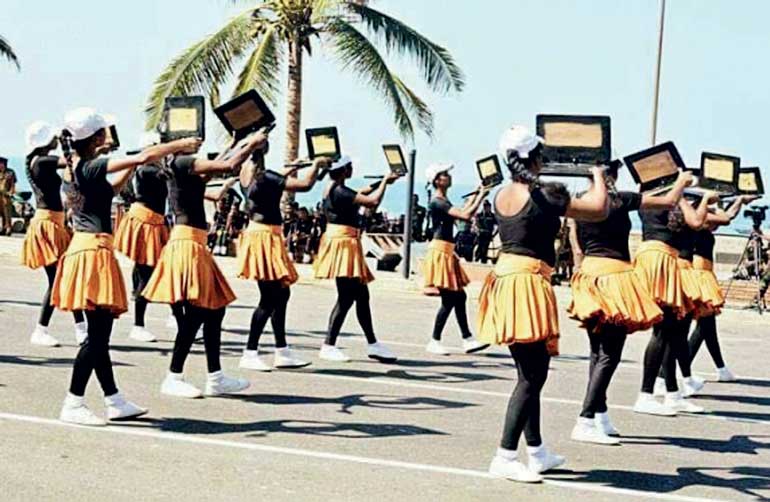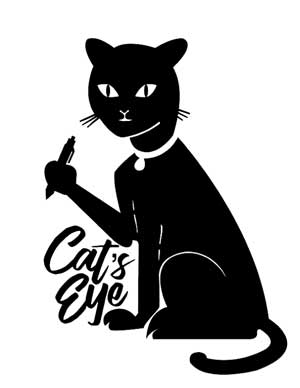Tuesday Mar 04, 2025
Tuesday Mar 04, 2025
Thursday, 8 March 2018 00:00 - - {{hitsCtrl.values.hits}}

The commentaries on the laptop dance is symbolic of the way in which the tropes of ‘culture’ and ‘tradition’ are used to limit women’s freedoms and aspirations, as well as obscure the realities of women’s lives. The choreography of young women replacing the tools of agriculture with instruments of science and technology stood out to us as a powerful vision for the role of women in Sri Lanka’s economy and future
Cat’s Eye is back! Here we offer a feminist gaze on current issues, debates and discussions in Sri Lanka and beyond. We’ve been keeping a watchful eye on the events of our country and we felt it was time to add our voices to the mix – we don’t want the experts to have all the fun, after all!
What have we been thinking about lately? We start with Sri Lanka’s most recent ‘milestone’ – our 70th anniversary of independence from British rule, and the unusual level of interest in the Independence Day parade this year.
The talk of the town in the days prior to the parade was the inclusion of a dance involving laptops and telescopes that was to be performed by young women from the Wayamba National College of Education in Bingiriya. Videos of these women practicing went viral on social media and photographs of the dancers were front page news.
The use of the laptops and telescopes rather than the kalaya (pot) or the kulla (winnowing fan) generated hoots of derision in the media. The powers that be initially decided to scrap the ‘controversial’ laptop dance from the parade before eventually relenting on the condition that the women eschewed their laptops in favour of bunches of flowers.
The many commentaries on the dance caught the attention of Cat’s Eye. Many commenters bemoaned the corruption of Sri Lankan culture by seeking to modernise a traditional dance. Some saw this as an unnecessary effort to impress the Earl and the Countess of Wessex. Given its proximity to the Local Government elections, others interpreted this as a ham-fisted attempt on the part of the Prime Minister to emphasise his promise of free Wi-Fi for all. All of this looked to our Eye to be eerily familiar.
Our sense of déjà vu was probably due to the similarities to the furore that erupted a few years ago over the operatic performance of the Sinhalese classic, ‘Danno Budunge’, by a professional opera singer (another young woman). As the status of women at Sri Lanka’s 70th year of independence comes into focus, Cat’s Eye reflects on what this ‘controversy’ means and portends for women in the country today.
Tradition, culture and women’s aspirations
The choreography of young women replacing the tools of agriculture with instruments of science and technology stood out to us as a powerful vision for the role of women in Sri Lanka’s economy and future.
At a time when there is global interest in increasing the number of women in Science, Technology, Engineering, and Medicine (STEM), and where in Sri Lanka, female students make up only 20% of students in Engineering, and slightly less than 50% in Computer Science and Science (UGC 2012, 2014) – (even though 62% of university students are women, largely concentrated in the arts, humanities and law faculties) – the optics of women from outside the Western Province reaching for the tools of technology should have been embraced and celebrated. Instead, these young women faced a harsh backlash.
One of the major criticisms of the dance focused on its lack of aesthetic value as compared to the traditional dances for women with the kulla and the kalaya. If these critics are to be believed, we must then come to the rather comic conclusion that the aesthetic value of a dance can only be appreciated on the strength of the dancers’ use of agricultural implements. In addition, let’s not forget that the construction of what is ‘aesthetically pleasing’ or not comes with its own class baggage and hints of elitism!
The sad truth is that what was at stake for many of these critics was not aesthetics but ‘culture and tradition’. Women are expected to represent and perform their ‘traditional’ roles in agriculture because it retains and maintains their position within the social hierarchy. Within this scheme, a woman’s aspiration for development through study and work in technology must be caricatured and squashed with sardonic humour followed by a governmental dictat to change the dance.
For Cat’s Eye, the commentaries on the laptop dance is symbolic of the way in which the tropes of ‘culture’ and ‘tradition’ are used to limit women’s freedoms and aspirations, as well as obscure the realities of women’s lives. For all the chest-beating about culture and traditional livelihoods, there is in fact precious little done to recognise women’s work in agriculture. Indeed, it is misrecognised in our economic statistics and as a result, often invisible at the national level.
At the same time, Sri Lanka’s agriculture sector is currently struggling to withstand the effects of the neoliberal mantra of a service-based economy, the pernicious effects of malfunctioning, nepotistic patronage networks, and climate change.
Even while Independence Day parades are still celebrating women’s roles in agriculture, women have long been leaving the agricultural sector, to work as cheap labour in factories, in the informal economy, or in foreign lands under conditions which are exploitative and precarious – and yet is, in some cases, still more liberating than the prospect of life at home.
It is when we look past the outrage on social media about ‘aesthetics’ and ‘tradition’, that we can get a better view of how Sri Lanka’s economic system works hand in hand with patriarchal power at the expense of women’s empowerment, advancement and participation in the workforce. Women’s aspirations to find good jobs are routinely dismissed and ridiculed, sometimes even violently. Consider the commentary around the 25% quota for women in local government!
Cat’s Eye wonders why the displays of (toxic) normative hetero-masculinity in the military parade on Independence Day didn’t lead to rigorous commentary as with the laptop dance. Surely, one could argue, the bluster of weapons, tanks and other implements of murder are more of an eyesore and an affront to the sentiments of this apparently peaceful, non-violent Buddhist nation, than the technological aspirations of young women? Is this display of military might even suitable in a country just nine years after the ‘end’ of a war, where some communities continue to live under military control?
Finally, what are we to make of the decision to allow the dance – for which these young women had no doubt given several hours rehearsing in the sun – to continue, but with the women holding flowers instead? Let us map the trajectory: we begin with the kulla or kalaya – objects symbolic specifically of the woman’s work in agriculture, but also of her role at home, in the kitchen: the ideal Sri Lankan woman, immersed in idyllic, rural life. We then leap to laptops and telescopes and finally, to flowers.
To us, it seems symbolic of our path to progress: just when we think we have liberated ourselves from the imprisonment of tired gender roles, and we reach for some measure of advancement, we are pulled back; but this time, it is made to appear less harmful, less of an obvious stereotype.
“We don’t want you in the kitchen anymore, but we don’t want you getting ahead, either. Here, hold some flowers.”
‘Pressing for Progress’: A women’s manifesto
Independence Day celebrations usually afford us an opportunity to reflect on the journey the country has taken so far and on its (hopefully) more promising future. So too, does International Women’s Day which we celebrate this week, for which ‘Pressing for Progress’ has been decided as the theme.
Reflecting on the journey so far, we can see that Sri Lankan women from different backgrounds and communities continue to negotiate their status in a society that promises them progress and at the same time ridicules their aspirations. Women have never been, and never will be, content with society’s oppressive, patriarchal vision of progress for them. Whether it is participation in politics, or their right to their lands and livelihoods or the right to their own bodies and lives, Sri Lankan women are challenging stereotypes, struggling against oppression and fighting for equality and justice.
A statement titled ‘We, Women’ signed by women’s rights activists and organisations and released to mark 70 years of independence, chronicles the hard-won, as well as continuing struggles of women in Sri Lanka in the social, political, economic and legal spheres. As they point out: ‘this as an important and interesting moment locally and globally, where women are challenging entrenched misogyny, resisting patriarchy, breaking silences, (and) disrupting power’.
Cat’s Eye returns after almost seven years at exactly this ‘important and interesting’ moment in time to rejoin the struggle.
(The Cat’s Eye column is written by an independent collective of feminists, offering an alternative feminist gaze on current affairs in Sri Lanka and beyond.)
Discover Kapruka, the leading online shopping platform in Sri Lanka, where you can conveniently send Gifts and Flowers to your loved ones for any event including Valentine ’s Day. Explore a wide range of popular Shopping Categories on Kapruka, including Toys, Groceries, Electronics, Birthday Cakes, Fruits, Chocolates, Flower Bouquets, Clothing, Watches, Lingerie, Gift Sets and Jewellery. Also if you’re interested in selling with Kapruka, Partner Central by Kapruka is the best solution to start with. Moreover, through Kapruka Global Shop, you can also enjoy the convenience of purchasing products from renowned platforms like Amazon and eBay and have them delivered to Sri Lanka.
Discover Kapruka, the leading online shopping platform in Sri Lanka, where you can conveniently send Gifts and Flowers to your loved ones for any event including Valentine ’s Day. Explore a wide range of popular Shopping Categories on Kapruka, including Toys, Groceries, Electronics, Birthday Cakes, Fruits, Chocolates, Flower Bouquets, Clothing, Watches, Lingerie, Gift Sets and Jewellery. Also if you’re interested in selling with Kapruka, Partner Central by Kapruka is the best solution to start with. Moreover, through Kapruka Global Shop, you can also enjoy the convenience of purchasing products from renowned platforms like Amazon and eBay and have them delivered to Sri Lanka.